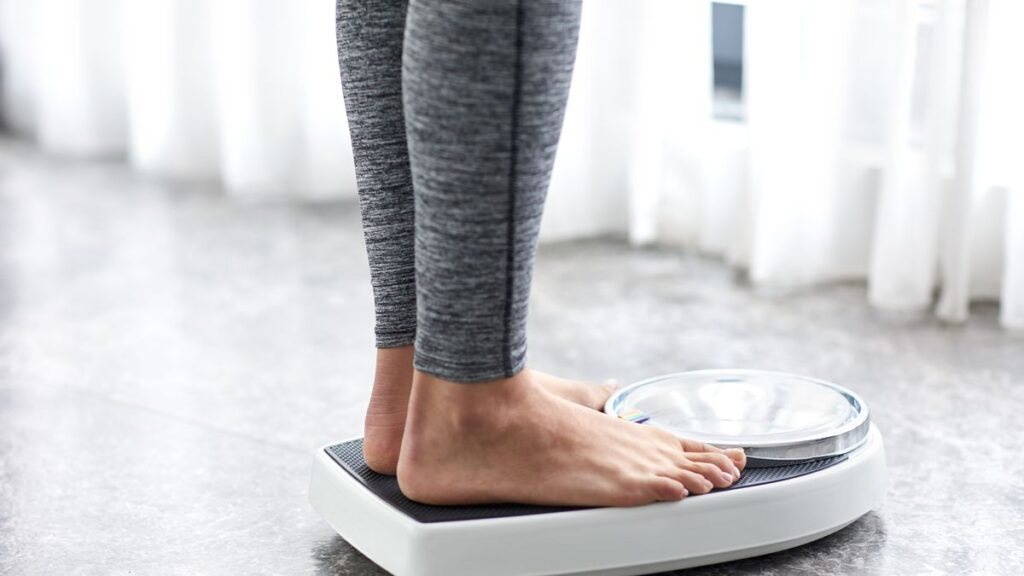Healthy weight loss requires a lifestyle that includes stress management, physical activity on a regular basis, and healthy eating habits. It’s normal to desire weight loss to occur quickly when striving to do so. Yet, persons who lose weight gradually and steadily (about 1 to 2 pounds per week) are more likely to keep it off.
After you’ve reached a healthy body weight, you can rely on a good diet and regular exercise to help you stay healthy in the long run.
Weight loss goals are frequently started with a lot of effort and determination but quickly fail once laziness and lack of discipline invade our life. We become nervous and confused regarding our actions and methods for getting in shape quickly when the need to reduce weight arises, perhaps in a month. But don’t worry, if you stay focused and adhere to a plan, anything is achievable.
Common causes of weight gain
The following list includes some typical explanations for weight gain:
- Genetics
- Medications
- Bad eating habits and overeating (Too much junk)
- Diet high in simple carbs
- Being physically inactive
- PCOS and various additional disorders including hypothyroidism, insulin resistance etc.
- Psychological issues
Trendy diets and supplements like Phenq and Trimtone available in the market may guarantee significant weight reduction which may seem very alluring, but these would just leave you to feel hungry and in the worst case scenario, they result in undesirable behaviors and subsequent gain in weight.
If you want to lose weight permanently, you must adopt a number of healthy lifestyle adjustments that boost your overall health.
Instead of losing excess fats fast, it is advisable to target losing 1 to 2 pounds per week, as reported by the Centers for Disease Control and Prevention (CDCP). This indicates that on average a healthy target would be to lose 4 to 8 pounds per month.
The following nutritional practices are advised by the CDC:
- consuming protein-rich foods such as lean meats, fish, poultry, beans, eggs and nuts
- consuming a lot of fruits, veggies, low-fat dairy products, and whole grains
- minimizing saturated fats, cholesterol, and trans fats
- reducing intake of items that contain a lot of sugar or added sugar
- minimizing salt consumption.
It does not necessarily mean that the overall weight will remain off in the long run merely because one has shredded extra pounds, presumably in the beginning few days of going on a diet.
It can be both very easy and very difficult to lose weight. We will always need to focus on our lifestyles because they are the cornerstone of any alteration we make. Body mass index (BMI), sex, and level of physical exercise are some examples of personal factors that affect a person’s specific weight reduction targets.
3,500 calories make up one pound. In order to drop 1 to 2 pounds each week, a person needs to achieve a calorie shortfall of 500 to 1,000 calories each day.
Strict low-calorie diets may help people lose weight more quickly, but they might come with drawbacks. The following dangers are associated with some popular diets, including the paleolithic diet, the ketogenic diet, and detox diets:
- Unreasonable constraints on food that exclude completely important food groups like legumes, whole grains, and dairy-based products can lead to malnutrition.
- The “yo-yo diet” impact, also referred to as weight cycling, is the method of losing weight and gaining it back.
- Muscle mass loss rather than a decrease in the body fat proportion
- More appetite or a slower metabolism.
- Diabetes and high blood sugar levels
A healthy diet and exercise regimen with the aim of improving your health will aid in weight loss and help you keep it off. It is essential to concentrate on both of your eating practices and increasing your physical exercise.
Your metabolism can get the boost it needs to burn additional calories through a combination of high-intensity interval training and strength training, such as weightlifting or performing bodyweight workouts. Exercise that involves sustained cardiovascular activity can also aid in calorie burning.
Also Read : Losing fat and keeping muscle can both be accomplished with cardio activities.
Suggestions for Long-Term Weight Loss
- Concentrate on Simple, Effective Changes
Work on altering food habits a handful at a time rather than going on a crash diet. Choose healthy habits over making weight reduction your main priority. A person with lower body weight does not always imply that he is healthy.
- Consume wholesome foods rather than fewer.
Consume nutritious meals almost all of the time and consume less processed food, alcohol, and sugary drinks. Filling your plate with whole grains, veggies, legumes, beans, fruits, poultry, fish and beneficial fats like olive oil, avocado, nuts or seeds will help you achieve your goal of losing excess body weight.
- Increase your water intake.
You can maintain an appropriate fluid equilibrium by drinking a lot of water, which can also help you feel fuller for longer and help you lose weight.
- Boost your protein intake.
Some studies suggest that consuming more foods that are high in protein may support regulating your appetite, reduce hunger pangs, and enhance feelings of satiety.
- Include exercise in your regimen.
To facilitate weight loss and overall wellness, healthy people should strive for 150 to 300 minutes of moderately strenuous activity or 75 to 150 minutes of intense physical workout each week.
- Incorporate more foods that are high in fiber.
The high fiber content of foods like vegetables, legumes, whole grains, and fruits can help reduce cravings and speed up weight reduction by delaying the emptying of the stomach.
8. Try some of the Top Diet Pills in the martet.
⇒Read this Review for more information
Additional options for weight loss
Apart from proper diet, physical activity and healthy lifestyle another great option to shed your excess weight is to perform Yoga Asanas.
Regular yoga practice aids in weight loss in a similar way to other aerobic exercise.
Combining breathing techniques and yoga postures has a favorable effect on metabolism, controls blood flow throughout the body, and promotes weight loss.
Yoga is an effective, affordable, non-invasive substitute for traditional weight loss methods, with the added benefits of long-term lifestyle modifications and beneficial psychological adjustments.
Salutation to the Sun (Suryanamaskar)
It provides a great cardio exercise. 12 yoga poses make up the Surya Namaskar collection, which is intended to offer your entire body a wonderful workout and this asana would help you lose weight.
Boat posture (Navasana)
Boat position, also known as Navasana, is extremely beneficial for developing a strong abdomen. With consistent practice, it also raises metabolism and lowers abdominal fat. This pose can help both men and women with balance, flexibility, and posture.
Bow Posture (Dhanurasana)
Dhanurasana, also known as the bow posture, is a great asana to promote abdominal fat burning. It functions by extending the muscles in the arms, legs, and midsection. Both males and women can practice this challenging yoga pose.
Plank posture (Phalakasana)
The plank position is ideal for strengthening your core and reducing tummy and arm fat. This yoga position is also quite effective at easing back discomfort. Also, performing phalakasana regularly is a fantastic stress reliever. It is a beneficial yoga pose to lose belly fat.
Cobra Pose ( Bhujangasana)
The cobra posture, also known as Bhujangasana, gives the muscles of the abdomen a thorough stretch and aids in belly fat reduction. This can be incorporated into the routine of both males and women in order to speed up metabolism.
Bridge position (Setu Bandha Sarvangasana)
Bridge pose is the ideal posture for you if you are searching for yoga poses to help you lose weight. It is a revitalizing form of back-bending yoga posture. It is highly effective for losing weight. Your body may feel energized, and you may become more limber.
Chair Posture (Utkatasana)
Chair posture, also known as Utkatasana, is beneficial for both sexes. It primarily targets the thighs, knees, and ankles. The position increases metabolism and expedites fat burning.
Upward-Facing Dog posture (Urdhva Mukha Svanasana)
Upward-Facing Dog, or Urdhva Mukha Svanasana, helps to tone the abdomen muscles and reduces belly fat. It has benefits that are attainable to both males and women.
Triangle posture (Trikonasana)
Trikonasana, also known as the Triangle Pose, encourages the development and strengthening of muscles in the arms, thighs, and core, which helps both men and women lose belly fat.
Chair Posture (Utkatasana)
This pose is fantastic for losing weight. The chair position results in a toned butt, legs, and a lean stomach. You might even get the hourglass shape you want with its aid! Additionally, this yoga position helps to develop muscles.
Conclusion
If you garner a little discipline and hard effort without losing concentration, one month’s time is not a short period of time to lose a few pounds. These methods may appear and sound easy, but adhering to them requires considerable self-control and determination.
Everybody is admirable and lovely. However, having a healthy physique can make you feel better in general, more comfortable, and more confident about yourself.
If a person makes a commitment to making overall lifestyle adjustments, such as improving their nutrition and upping their weekly physical exercise, they would definitely achieve their expected weight loss target.









